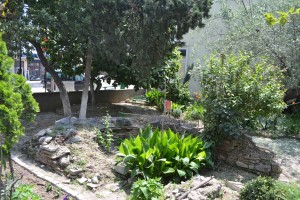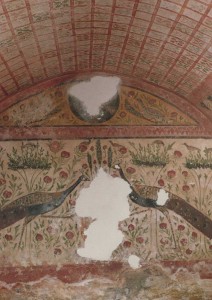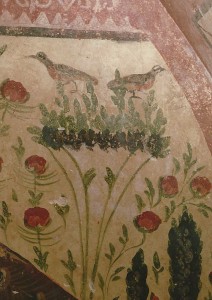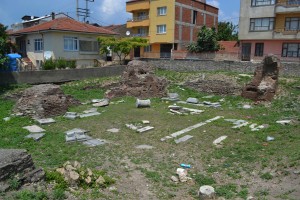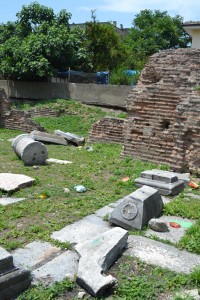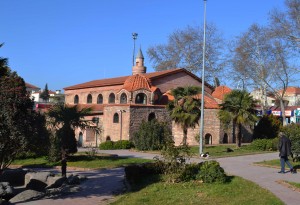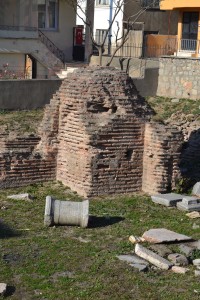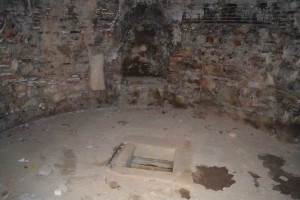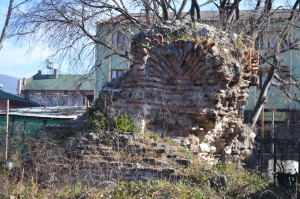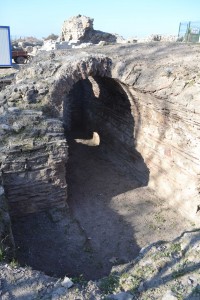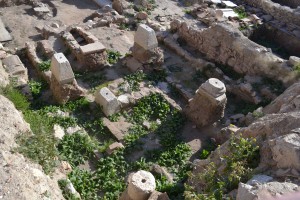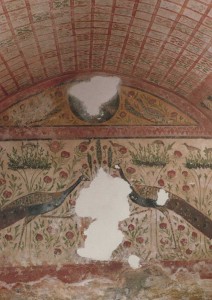Archive for June 14th, 2016
Nicaea was the capital-in-exile of the Byzantine Empire during the period of Latin occupation of Constantinople. The city’s new prominence meant the construction of many churches between 1204 and 1261. Slow centuries of neglect during Ottoman occupation were followed by sudden destruction as the Greek army was driven back to the Aegean in the War of Independence. Most churches in Iznik were levelled. This one is near the Istanbul Gate. It may have been dedicated to St. Tryphon, as may one at the opposite end of the town near Yenişehir Gate. This church has suffered further indignities in recent times as a street has been built over part of it and the remaining walls now serve as seating in a small public park. There is so little left that I don’t think anyone has bothered to study it in any sort of academic sense.
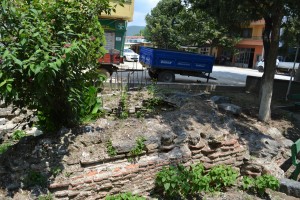
The highest part of the remaining walls.

Posted June 14, 2016 Posted by Adam in Uncategorized
This tomb (below) was built in the 4th or 5th century. It is about 5km north of Iznik, near the village of Elbeyli. The Byzantines, here and elsewhere, showed a great fondness for birds.
This tomb has been subjected to several indignities over the years. The big blank between the peacocks marks the spot where a thief broke through the back wall in 1976 in search of treasure. In 1995, five years after these photos were taken, a section of the wall with a fresco of a partridge was removed. Presumably, this will surface on the international art market at some stage.

Posted June 14, 2016 Posted by Adam in Uncategorized
The Church of the Dormition (Koimesis) in the south-west of the city (40.433715, 29.717429) was probably built in the late 6th century. Its mosaics were documented in 1898 and the photographs of Theodore Schmit taken in 1912 are all that remains of these fine artworks. The mosaics appear to have originated in the 11th century. Cyril Mango has, as is his wont, made a detailed explanation of why they should be dated to a period in the second half of the century and not earlier. The church was dynamited by Turkish troops in 1921 or 1922. There is not much left. It is even difficult to see the floor plan of a Greek cross with a longer apse than normal.
Some beautiful pieces of marble from the church will be on display at Iznik’s Archaeological Museum when it eventually reopens.

Posted June 14, 2016 Posted by Adam in Uncategorized
Nicaea was the home of the Greek Patriarchate during the Latin occupation of Constantinople. Its fame has lasted due to the persistence of the Nicene Creed in the liturgy. This is a heavily edited statement of the outcome of the First Ecumenical Council of 325, held to discuss the nature of the Christ. It was determined that he was begotten, not made, that is, that he was of the substance of the Father, rather than made anew. This disposed of the Arian Controversy, thereafter called the Arian Heresy.
That Council was held in the Senatus Palace complex of Constantine I, which appears to have sunk beneath the waters of Lake Iznik in various episodes of tectonic activity, particularly the earthquake of 740. The foundations of a basilica were discovered in 2014 about 20 metres from the current shoreline. The lake is fertile territory for future aquatic archaeological investigation. However, the terrestrial city has plenty of interest.
The thirteenth century flowering of Nicaea as the home of the exiled Patriarchate led to the construction of a number of churches and the repair of existing ones. However, after Ottoman conquest, the city of Iznik was impoverished and underpopulated. The churches gradually became more and more dilapidated until the Turkish War of Independence. Iznik was in the path of the Turkish Army which, scenting victory, drove the hapless Greek population towards the Aegean coast. Iznik, having a large Christian presence, was a target. All churches were destroyed with the exception of Aya Sofya, which had been converted into a mosque.
New techniques are resulting in the discovery of churches that had disappeared from knowledge. A basilica, possibly the one in which the Nicene Creed was formulated, was recently found in shallow water in İznik Gölü (40.429123, 29.710134). Another church was rediscovered in the north-west of the town (40.433715, 29.717429) with a combination of magnetic mapping, ground-penetrating radar, gravimetry and electric resistivity tomography. There are many more churches to rediscover.
1. Hagia Sophia / Iznik Ayasofya Camii
2. Church of the Dormition (Koimesis)
3. Böcek Ayazması
4. Iznik Church 1, Istanbul Gate / Hagios Tryphonos Church / Ayatrifon Kilisesi
5. Iznik Church 2, Yenişehir Gate / Hagios Tryphonos Church / Ayatrifon Kilisesi
6. Church near Iznik Theatre
7. Church in excavations behind the Archaeological Museum
8. Elbeyli Byzantine Tomb.
Rabbel, W. et. al. (2014) Discovey of a Byzantine Church in Iznik/Nicaea, Turkey: An Educational Case History of Geophysical Prospecting with Combined Methods in Urban Areas. Archaeological Prospection. Wiley Online Library. Available online at: https://www.academia.edu/8489685/Discovery_of_a_Byzantine_Church_in_Iznik_Nicaea_Turkey Accessed 15th June 2016.
Powell, E. (2014) Sunken Byzantine Basilica. Archeology. Archeological Institute of America. Available online at: http://www.archaeology.org/issues/161-1501/features/2789-turkey-submerged-byzantine-basilica Accessed 15th June 2016

